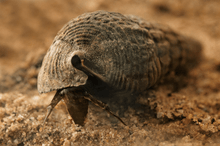Cerithioidea
| Cerithioidea Temporal range: Triassic–Recent[1] | |
|---|---|
 | |
| A live individual of Terebralia palustris, family Potamididae | |
| | |
| A beachworn shell of Maoricolpus roseus, family Turritellidae. Most of the body whorl has been broken off in this specimen, possibly by a predator such as a crab. | |
| Scientific classification | |
| Kingdom: | Animalia |
| Phylum: | Mollusca |
| Class: | Gastropoda |
| (unranked): | clade Caenogastropoda clade Sorbeoconcha |
| Superfamily: | Cerithioidea Fleming, 1822 |
| Diversity[2] | |
| 1092-1164 extant species about 200 extant genera 17 extant families | |
The Cerithioidea is a superfamily of marine, brackish water and freshwater gastropod containing more than 200 genera. The Cerithoidea are included in the clade Sorbeoconcha. The original name of this superfamily was Cerithiacea, in keeping with common superfamily endings at the time.
Ecology
Cerithioidea is a very diverse superfamily. Its species can be found worldwide mainly in tropic and subtropic seas on rocky intertidal shores, seagrass beds and algal fronds, but also in estuarine and freshwater habitats. The freshwater species are found on all continents, except Antarctica. They are dominant members of mangrove forests, estuarine mudflats, fast-flowing rivers and placid lakes.[3]
Fossil record
Their fossil record of this superfamily can be traced back as far as the early Triassic[1][4] but they began radiating mainly during the Cretaceous.[5]
Taxonomy
The Cerithioidea are presumed to be monophyletic (one lineage).[6] However the phylogenetic relationships between its families are still under investigation because Mitochondrial recombinant DNA sequences failed to resolve these questions.
2005 taxonomy
According to the Taxonomy of the Gastropoda (Bouchet & Rocroi, 2005),[7] the following families are included in Cerithioidea:
- Batillariidae Thiele, 1929 - monophyletic
- † Brachytrematidae Cossmann, 1906
- † Cassiopidae Beurlen, 1967
- Cerithiidae Fleming, 1822 - monophyletic
- Dialidae Kay, 1979
- Diastomatidae Cossman, 1894
- † Eustomatidae Cossmann, 1906
- † Ladinulidae Bandel, 1992
- † Lanascalidae Bandel, 1992
- Litiopidae Gray, 1847
- † Maoraxidae Bandel, Gründel, Maxwell, 2000
- Melanopsidae H. Adams & A. Adams, 1854 - freshwater snails, polyphyletic
- † Metacerithiidae Cossmann, 1906
- Modulidae P. Fischer, 1884
- Pachychilidae P. Fischer & Crosse, 1892
- Paludomidae Stoliczka, 1868
- Pelycidiidae Ponder & Hall, 1983
- Planaxidae Gray, 1850
- Pleuroceridae P. Fischer, 1885 (1863) - freshwater snails, polyphyletic
- † Popenellidae Bandel, 1992
- Potamididae H. Adams & A. Adams, 1854 - monophyletic
- † Procerithiidae Cossmann, 1906 - If the genus Argyropeza is placed in the Procerithiidae, then this family is no longer exclusively a family of fossils.
- † Prostyliferidae Bandel, 1992
- † Propupaspiridae Nützel, Pan & Erwin, 2002
- Scaliolidae Jousseaume, 1912 - monophyletic
- Siliquariidae Anton, 1838
- † Terebrellidae Delpey, 1941 - not a valid name
- Thiaridae Gill, 1871 (1823) - freshwater snails, polyphyletic
- Turritellidae Lovén, 1847 - monophyletic
(Extinct taxa indicated by a dagger, †.)
It is possible that a further detailed examination may show that the polyphyletic families Melanopsidae and Pleuroceridae are one family. There is also a close phylogenetic relationship between the families Modulidae and Potamididae and between the families Cerithiidae and Litiopidae.
2006 taxonomy
Bandel (2006)[1] made numerous changes in Cerithioidea. He classified superfamily Cerithioidea in the clade Cerithimorpha.[1]
Changes include:
superfamily Cerithioidea
- family Bittiidae Cossmann, 1906 - consider Bittiidae in its own family level. It was as subfamily Bittiinae within Cerithiidae by Bouchet & Rocroi, 2005.
- family † Maturifusidae - moved to Cerithioidea from Hypsogastropoda
- family † Canterburyellidae - moved to Cerithioidea from unallocated Sorbeoconcha
- family † Prisciphoridae - moved to Cerithioidea from unallocated Sorbeoconcha
- family † Zardinellopsidae Bandel, 2006 - new family
- family Pachymelaniidae - considered as valid family. It was as synonym of Thiaridae.
- some Pyrguliferidae members (a synonym) are in Paludomidae and some are in Paramelaniidae (instead of Thiaridae)
- family Paramelaniidae at family level (instead of a synonym of Paludomidae)
- and some moves to other taxa
2009 taxonomy
- Subfamily Semisulcospirinae within Pleuroceridae was elevated to family level under the name Semisulcospiridae by Strong & Köhler (2009).[8]
References
- ↑ 1.0 1.1 1.2 1.3 Bandel K. (2006). "Families of the Cerithioidea and related superfamilies (Palaeo-Caenogastropoda; Mollusca) from the Triassic to the Recent characterized by protoconch morphology - including the description of new taxa". Freiberger Forschungshefte C 511: 59-138. PDF.
- ↑ Strong, E. E.; Colgan, D. J.; Healy, J. M.; Lydeard, C.; Ponder, W. F.; Glaubrecht, M. (2011). "Phylogeny of the gastropod superfamily Cerithioidea using morphology and molecules". Zoological Journal of the Linnean Society 162: 43. doi:10.1111/j.1096-3642.2010.00670.x.
- ↑ Healy J. M. & Wells F. E. (). Mollusca, The Southern Syntthesis. Fauna of Australia. Melbourne, CSIRO publishing. 707 pp.
- ↑ Tracey S., Todd J. A. & Erwin D. H. (1993). The Fossil Record. London, Chapman & Hall. pages 131-167.
- ↑ Houbrick R. S. (1988). "Prosobranch Phylogeny". Malacological Review, Supplement 4: 88-128.
- ↑ Colgan, D. J.; Ponder, W. F.; Eggler, P. E. (2000). "Gastropod evolutionary rates and phylogenetic relationships assessed using partial 28S rDNA and histone H3 sequences". Zoologica Scripta 29: 29. doi:10.1046/j.1463-6409.2000.00021.x.
- ↑ Bouchet P., Rocroi J.-P., Frýda J., Hausdorf B., Ponder W., Valdés Á. & Warén A. (2005). "Classification and nomenclator of gastropod families". Malacologia: International Journal of Malacology (Hackenheim, Germany: ConchBooks) 47 (1-2): 1–397. ISBN 3925919724. ISSN 0076-2997.
- ↑ Strong, E. E.; Köhler, F. (2009). "Morphological and molecular analysis of 'Melania' jacquetiDautzenberg and Fischer, 1906: From anonymous orphan to critical basal offshoot of the Semisulcospiridae (Gastropoda: Cerithioidea)". Zoologica Scripta 38 (5): 483. doi:10.1111/j.1463-6409.2008.00385.x.
External links
- Lydeard C., Holznagel W. E., Glaubrecht M. & Ponder W. F. (2002). "Molecular Phylogeny of Circum-Global, Diverse Gastropod Superfamily (Cerithioidea: Mollusca : Caenogastropoda) - Pushing the Deepest Phylogenetic Limits of Mitochondrial LSU rDNA Sequences". Molecular Phylogenetics and Evolution 22 (3): 399–406. doi:10.1006/mpev.2001.1072. PMID 11884164.